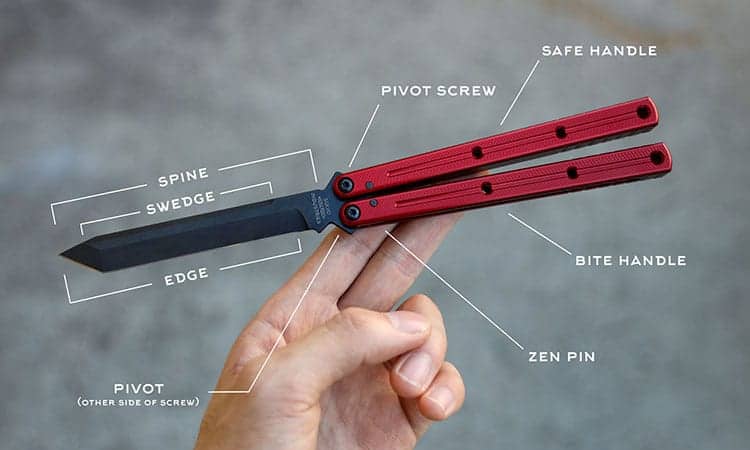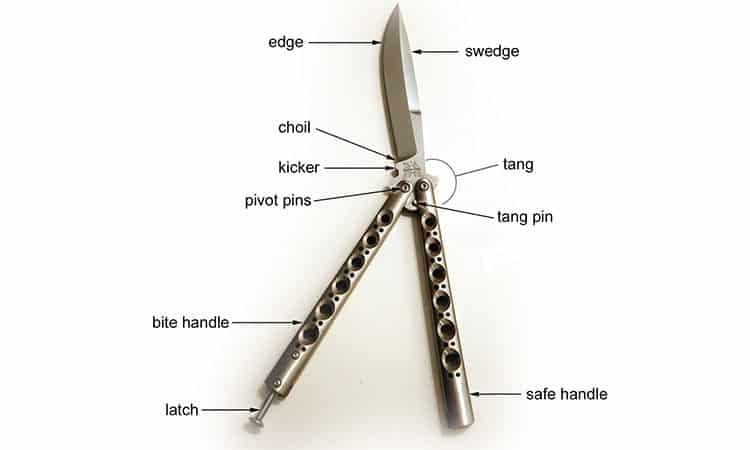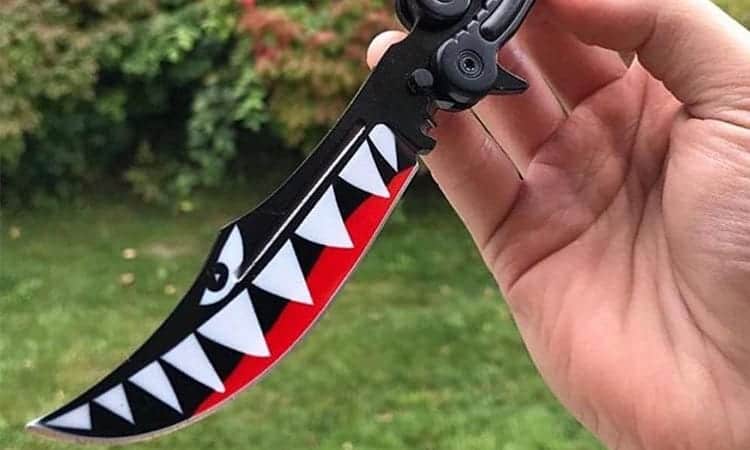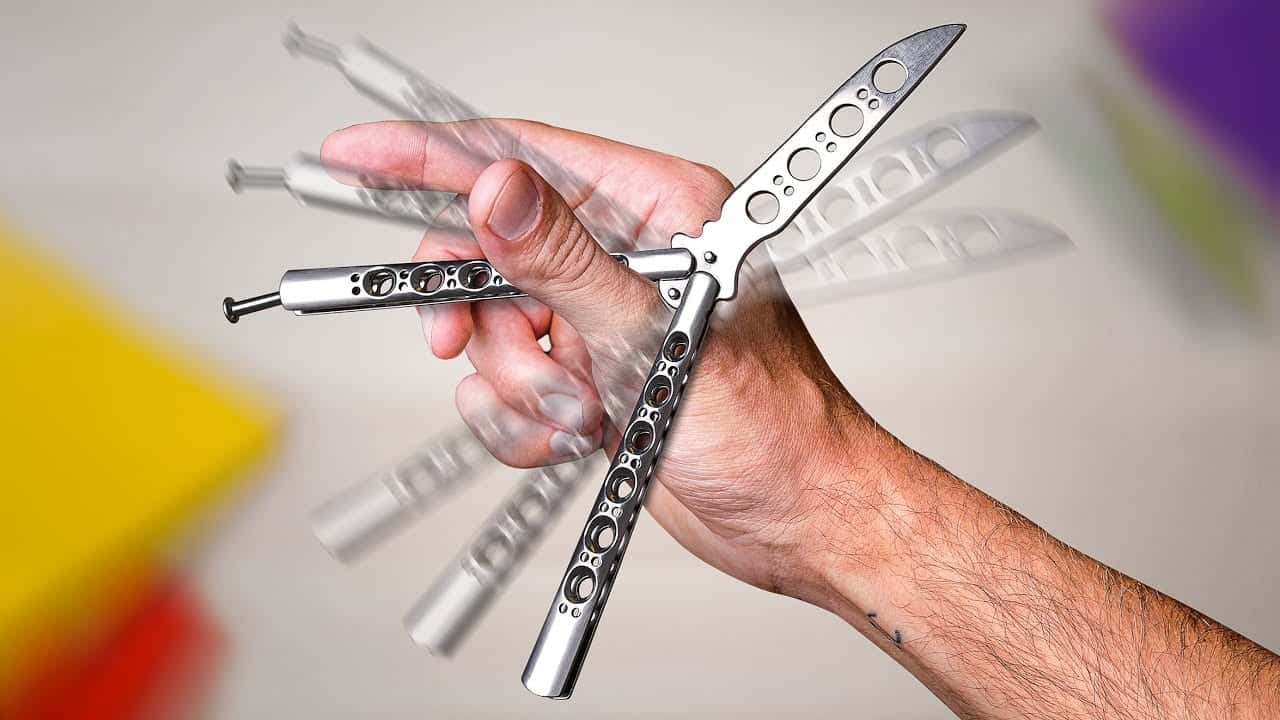Butterfly knives are some of the most unique-looking pocket knives you can buy. The dual handles give the knife its signature look.
While butterfly knives were most popular in the Philippines for a certain time, many hikers and campers use them as utility knives.
You may be thinking of investing in a butterfly knife for this purpose, but you should first know how to handle it. It is easy to injure yourself with a butterfly knife since it has so many moving parts.
This article will explain what a butterfly knife is and will cover the basic anatomy of the knife. Most importantly, we will explain how to use a butterfly knife.
We will also cover a few butterfly knife tricks. Let’s dive into it.
What Is a Butterfly Knife?

To understand how to use a butterfly knife, you should first understand what a butterfly knife is.
A butterfly knife is a folding pocket knife that came from the Philipines. Butterfly knives are also called balisong knives, fan knives, and Batangas knives.
The feature that people know butterfly knives for is the dual handles that counter-rotate.
The two handles conceal the blade when they are closed since they have grooves that the blade can fit in.
Butterfly knives have had a few purposes throughout the years. In the Philipines, these knives were popular self-defence weapons. Many people also used them as basic utility knives.
Like many other knives, butterfly knives are restricted or illegal in some countries.
For this reason, it is not as common to carry butterfly knives in the Philippines.
While it may be illegal to carry in some countries, you can still use the knife in other countries for different purposes. Many people still use the butterfly knife as a utility knife since the blade is just as strong as fixed blades.
People bring butterfly knives along with them while camping, hiking, hunting, backpacking, and fishing.
Campers and hikers love the butterfly knife because the blade can lock in a closed position. It will never accidentally deploy and injure you.
Some models also work well in wet environments. For instance, butterfly knives with skeletonized handles dry quickly, so lots of people use them while rafting.
Know the Anatomy of Your Knife

The butterfly knife is a complex small weapon. Let’s take a look at all of the main components of a butterfly knife.
- Bite handle: This part of the handle covers the sharp part of the knife blade. If you are holding the bite handle while closing the blade, you will get cut.
- Safe handle: This handle is the one that closes on the edge of the blade that is not sharpened. You won’t be injured if you are holding the safe handle while attempting to close the knife.
- Kicker: The kicker is what prevents the blade from coming into contact with the inside of the knife handle. If the blade touches the inside, it could be damaged.
- Choil: This part is just above the kicker. The choil is an unsharpened part of the blade which makes it easier to sharpen the knife blade.
- Latch: The latch holds the butterfly knife closed and prevents it from opening at unexpected moments. Some butterfly knives also have magnets that act as a sort of latch.
- Swedge: The swedge is the spine of the blade and is unsharpened. However, some models will have a sharpened swedge or even wavy edges.
- Zen pins: These pins are located inside of the handles near the kicker. The screws prevent the knife blade from moving around too much while the knife is open and closed.
- Tang: This part is the base of the knife blade. The tang is where pivot pins connect the handle to the blade.
- Tang Pins: The tang pins have an important job; they keep the blade away from the knife’s handle while it is closed. The purpose of this feature is that the handle could cause the blade to dull. Some knives will also have a second pin. This pin will prevent the blades from hitting each other while the user is handling the knife.
- Blade: Last but not least is the blade itself. The blade is a piece of steel that has one sharp side and one dull side. The two handles of the butterfly knife secure the blade while it is closed.
These are all of the main parts of the butterfly knife. However, we did not mention a few extra parts, such as the latch gate, pivot joint, latch spring, and latch Batangas.
All butterfly knives are not necessarily the same, but you will typically find all of the basic parts on the list above on each knife.
How to Properly Use It
Now that we know what a butterfly knife is and are familiar with the anatomy let’s figure out how to use a butterfly knife.
Opening the Knife
There are lots of different ways to use a butterfly knife. However, we will first cover the basic flip; this is the easiest way to use a butterfly knife.
Start by Holding the Knife by the Dull Side
There are two sides to a butterfly knife blade; a dull side and a sharp side. To avoid injury, you will have to start by holding the knife from the safe handle. You should also ensure that the knife is closed before handling.
To figure out what side is the dull side, you will need to look at the anatomy of the butterfly knife. Try to determine what side the sharp side of the blade folds into and avoid holding it by that side.
Hold the Knife in Front of You and Flick Your Wrist Back
Now that you are properly holding the knife hold it directly in front of you. It should be pointing forwards. You can now flip your wrist in a backwards motion.
When you flip your wrist back, the bite handle will flip back and hit you near the thumb and forefinger of your hand. Try not to move your hand when this happens.
Flip the Knife Again
The next step is to flip the knife again. This time around, you will flip your wrist in a full circle, which will close the knife. While it won’t be in the same position, the knife should look similar to how it looked when you started.
Move Your Thumb and Flip the Knife Up
Move your thumb to the side of the handle and out of the way. Once you move your thumb, flip the knife in an upwards motion. The bite handle will connect with the safe handle and lock into place. This action will engage the knife. It is now ready to use.
Using the Knife
You can use the butterfly knife either as a self-defence weapon or as a simple utility knife. However, you will need to be aware of the law and make sure it is legal to carry and use a butterfly knife in your region.
When using the knife, try to become familiar with the dull side and what side is the sharp side. You could easily injure yourself or others if you don’t know the anatomy of the knife.
Butterfly Knife Tricks

Now that we know how to use a butterfly knife let’s take a look at some tricks.
- The fan: To do the most simple and safest version of the fan, open the knife and hold the knife by the safe handle. Then, simply move your hand in a circular motion. The blade and the other handle should spin quickly like a fan.
- Double rollout: While this isn’t necessarily a move in itself, many use this move to lead into other butterfly knife tricks. Start by pinching the safe handle near the top of the knife with your thumb on one side and four fingers on the other. Then fling the bite handle up and towards the back of your hand. Now, flip the back of the blade (the dull side) over to the back of your hand. You can repeat this motion as many times as you want.
- Y2K: Hold the bite handle with your thumb and index finger like you would with a pencil. Flip the safe handle down. As the safe handle circles around into your thumb, let go of the knife completely, leaving your thumb in between the two handles. Once the knife rolls around, grab the safe handle and fling the bite handle forward. Then flip the bite handle back up again and secure the two handles together. Your knife is now activated and ready to go.
Conclusion
We hope that this guide has helped you learn how to use a butterfly knife.
The most important thing to know is that the knife has two handles; the bite and the safe handle. You won’t be injured while holding the safe handle, but you may get cut while holding the bite handle.
To open the knife, hold the knife by the safe handle and point it in front of you. Now flip your wrist back; the bite handle should flip back and hit your hand.
You can now flip your wrist in a full circle motion. Move your thumb to the side and flip the knife again in an upwards motion. The knife should now be ready to use.

